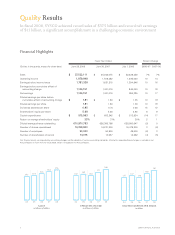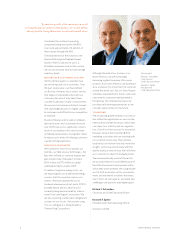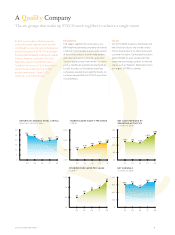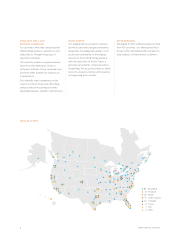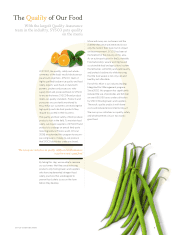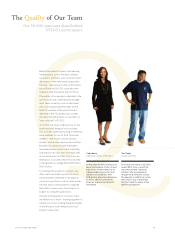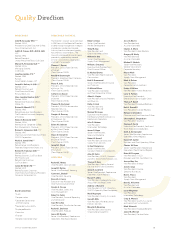Sysco 2008 Annual Report Download - page 10
Download and view the complete annual report
Please find page 10 of the 2008 Sysco annual report below. You can navigate through the pages in the report by either clicking on the pages listed below, or by using the keyword search tool below to find specific information within the annual report.
Operational excellence is one of the qualities
that sets SYSCO apart. When we began to
explore a national supply chain initiative
several years ago, we envisioned leveraging
our purchasing power and creating more
efficient transit from supplier to customer,
better inventory management, and easier
ordering for customers.
As the initiative has become reality, we are
realizing many of the anticipated benefits.
With skyrocketing energy costs, supply
chain efficiencies are translating into signifi-
cant fuel cost avoidance across the system.
Our supply chain initiative consists of three
components: a Transportation Management
System, a series of redistribution centers
(RDCs), and a Demand Planning and
Replenishment system.
The Transportation Management System,
which was fully implemented in 2007, has
increased our inbound shipping efficiency.
One way the system has helped reduce
inbound truck miles is by reducing the empty
space on each truckload.
RDCs allow us to aggregate supplier orders,
more efficiently manage inventories and
provide faster turnaround to our local
operating companies. Our second RDC,
in Alachua, Florida, opened on schedule in
April 2008 and is now shipping product.
These regional facilities also have rail
access, allowing us to now move eight
percent of our case volume by rail for
cost savings.
In addition to the RDCs, we continue to
establish foldout warehouses in strategic
locations. Our Knoxville facility is now
shipping product, and our East Texas facility
will open in October 2008.
On the outbound side, we have also revamped
our delivery system, working with our
customers to map deliveries using the most
fuel-efficient route, reduce idle time by
making night deliveries, and establish desig-
nated delivery days for our customers. With
approximately 9,000 trucks on the road –
the industry’s largest private fleet – savings
in this area can have a significant impact.
The Demand Planning and Replenishment
system increases our ability to forecast
demand and plan purchases. This is a
ben efit to our suppliers, who receive better
information for their planning purposes,
a savings for us in more accurate inventory
levels, and an advantage for our customers,
who have access to broader product
choices with shorter lead times for
maximum freshness.
Separately, we continue to move forward
with our centralized purchasing program,
or sourcing. This process allows us to buy
product more cost effectively while com-
mitting certain volumes to suppliers who
participate in the program. The early returns
have been encouraging and we expect to
continue to roll out this program throughout
the next several years.
COSt COntainMEnt
In a period of rising fuel and food costs, cost
containment is a key to operational excel-
lence. In addition to the savings achieved
through our supply chain and sourcing, we
are also implementing best practices across
the company, addressing cost reductions
through hundreds of other daily actions.
These include:
• Standardization of operational methods
including reducing the number of stops
per route, reducing idling time and limit-
ing truck speed to 60 miles per hour
• XY routing to reduce the number of
miles driven
• Warehouse energy-saving improvements
• Use of technology to improve productivity
and increase the number of cases per truck
“Sup√y chain e∂ciencies are tran≈ating into significant fu≤ co◊
avoidance across the SYSCO sy◊em.
”



